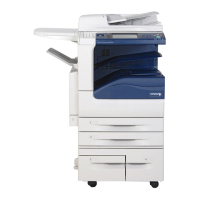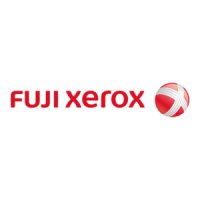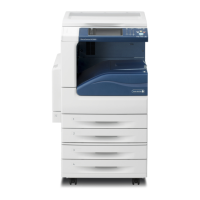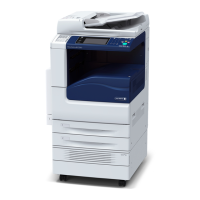
Do you have a question about the Fuji Xerox DocuCentre-IV 3065 and is the answer not in the manual?
| Brand | Fuji Xerox |
|---|---|
| Model | DocuCentre-IV 3065 |
| Category | All in One Printer |
| Language | English |
Introduction to the user guide, machine operation, and precautions for effective use.
Overview of accompanying manuals and guides for optional components.
Explanation of the guide's structure, intended audience, and how to use it.
Essential safety instructions, warning symbols, and precautions for product use.
Information on radio frequency emissions and product safety certifications (UL, CB).
Guidelines for environmental protection, toner cartridge recycling, and proper disposal.
Details on software licenses, including copyright and usage terms for various components.
Information on legal restrictions regarding copying or printing certain documents.
Description and functions of the machine's various parts and components.
Information on the power switch, main power switch, and switching the machine on/off.
Details on the ground fault interrupter, its function, and how to check its operation.
Explanation of Low Power mode and Sleep mode to reduce power consumption.
Description of the names and functions of components on the control panel.
Description of fields and buttons on the [Services Home] screen for service selection.
Instructions on how to enter text, including numerals, alphabets, and symbols.
Procedure for installing the tray attachment on the Finisher-B1 for neat output stacking.
Step-by-step guide for loading documents, selecting features, and starting copy jobs.
Available operations during copying, including stopping, changing quantity, and interrupting.
Setting basic copy features easily on a single screen.
Detailed settings for copy operations, including reduce/enlarge and paper supply.
Features for selecting document type, adjusting density, and background suppression.
Options for adjusting layout, including 2-sided copying, book copying, and edge erase.
Features for controlling output format, such as booklet creation and page per side.
Features for combining multiple scanned documents or print jobs into a single job.
Step-by-step guide for loading documents, selecting features, specifying destinations, and starting fax jobs.
Available operations during faxing, including stopping jobs and changing scan settings.
Overview of Internet Fax, its features, and transmission methods.
Explanation of IP Fax (SIP) technology for faxing over IP networks.
Information on using the Server Fax service for transferring image data.
Setting basic fax features easily on a single screen.
Detailed settings for fax and Internet Fax services.
Features for adjusting fax layout, including 2-sided scanning and original size.
Options for fax and Internet Fax, including acknowledgment reports and starting rate.
Additional fax features like remote polling, store for polling, and on-hook operations.
Features for broadcasting faxes to multiple recipients and using relay stations.
Modes for receiving faxes (Auto Receive, Manual Receive) and fax number filtering.
Information on subscriptions and procedures for facsimile information services.
Step-by-step guide for loading documents, selecting features, and starting scan jobs.
Available operations during scanning, including stopping jobs and changing scan settings.
Scanning documents and sending them as e-mail attachments.
Scanning documents using job templates for transfer to network destinations.
Scanning documents and sending data to a network computer via FTP or SMB.
Scanning documents and saving scanned data in a machine folder.
Scanning documents and saving scanned data to a USB memory device.
Scanning data, saving it temporarily, and notifying the user via e-mail with retrieval URLs.
Scanning documents from a network computer and saving data to a network computer.
Advanced scanning settings like photographs, image options, and color space.
Features for adjusting scan layout, including 2-sided scanning and original size.
Options for e-mail and filing, including quality, receipts, file names, and encryption.
Basic procedures for operating files stored in folders.
Procedure for selecting a folder to operate on, considering authentication settings.
Checking and operating files within a selected folder, including display styles and file types.
Previewing selected files to check details like whole page view, rotation, and file name.
Printing selected files from a folder, including print quantity and output settings.
Registering transfer settings for scan data to simplify data transfer tasks.
Procedure for operating job flows, including opening the screen and starting jobs.
How to select, confirm, change, and search for job flow sheets.
Explanation of the Stored Programming service for saving and calling job settings.
Procedures for registering, deleting, and renaming stored programs.
How to call a stored program from the Services Home screen or for Build Job.
Overview of the USB Media Print Kit, supported file formats, and restrictions.
Instructions for inserting a USB memory device and handling detected screens.
Methods for selecting files from a USB memory device for printing.
Setting printing options for Media Print - Text, including paper supply and output.
Overview of checking and operating current, pending, and completed jobs.
How to check current/pending jobs, cancel, or preferentially execute them.
How to check completed jobs, their details, and related job histories.
Procedures for printing or deleting jobs stored via Secure Print, Sample Set, or Charge Print.
How to forcibly print pending jobs or resume paused jobs.
Methods for handling error terminations for print, fax, and scan jobs.
Overview of features performable from a computer: printing, e-mail, fax, and data import.
Describes how to print documents using the machine's print features from a computer.
Sending e-mail with documents attached from a computer for automatic printing.
How to send a fax directly from a computer using the Direct Fax feature.
Methods to import files from the machine's folder to a computer.
Using a web browser to view machine status, jobs, change settings, and import files.
Definitions of terms used throughout the user guide.











